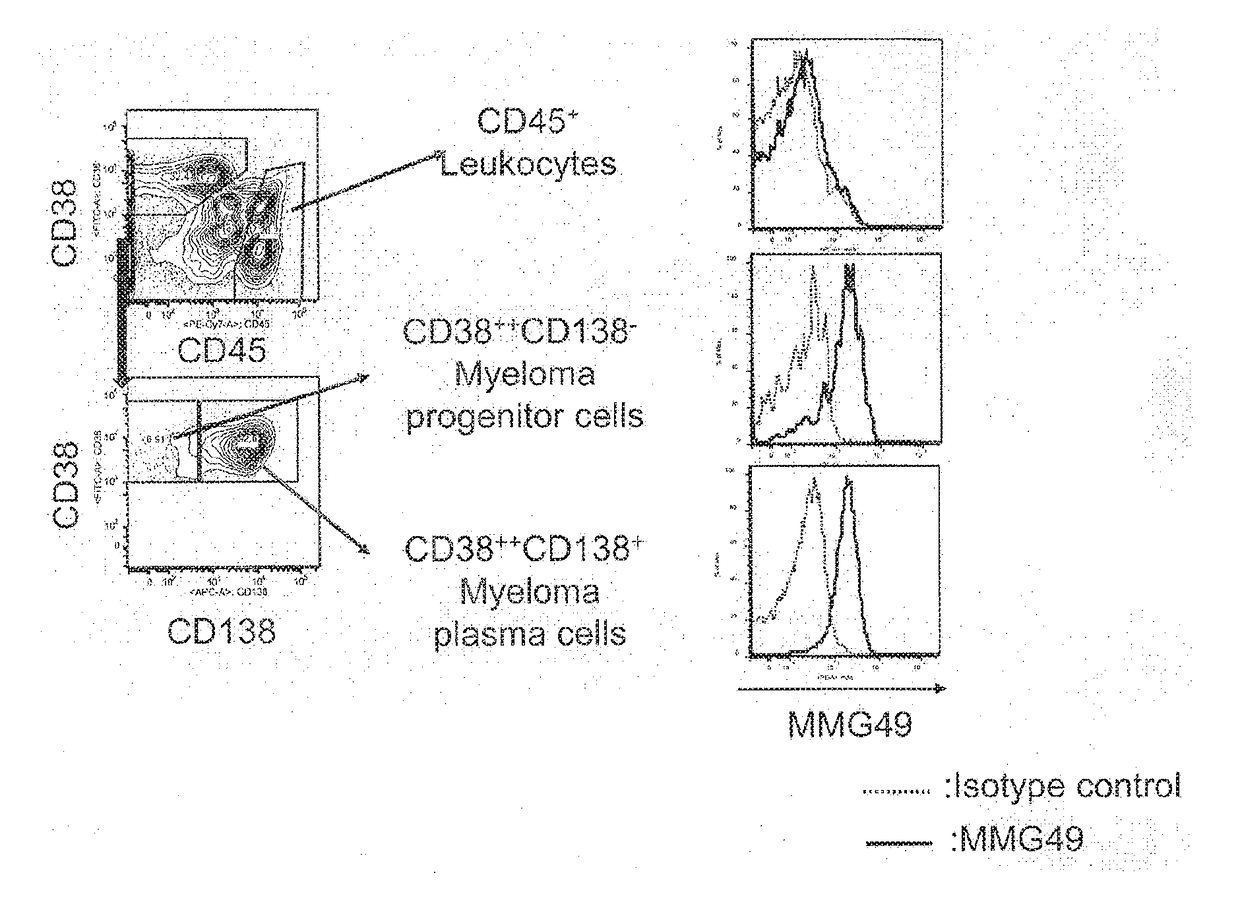Antibody
- Summary
- Abstract
- Description
- Claims
- Application Information
AI Technical Summary
Benefits of technology
Problems solved by technology
Method used
Image
Examples
example 1
[0364]Generation of Monoclonal Antibody Library that Binds to Myeloma Cell Line and does not Bind to Healthy Person Peripheral Blood
[0365]In antibody therapy against multiple myeloma, it is important to use an antibody that binds to myeloma cells but does not bind to normal blood cells. In view of this, such antibody was identified by the following method. First, 10,000 clones or more of monoclonal antibodies that bound to various myeloma cell lines were generated using the following technique.
[0366]Balb / c mice were immunized at the footpad twice a week for from 2 weeks to 3 weeks through use of six kinds of human myeloma cell lines (MM.1s cells, RPM18226 cells, INA6 cells, U266 cells, OPM2 cells, and KMS12BM cells) as antigens. After that, a lymph node below the knee was removed, and a cell suspension was generated and subjected to cell fusion with a SP2 / 0 mouse myeloma cell line to generate hybridomas. The cell fusion was performed using a method using polyethylene glycol (PEG met...
example 2
[0368]Identification of Antibody that Specifically Binds to Myeloma Cells in Human Multiple Myeloma Patient Bone Marrow
[0369]About 200 clones of candidate antibodies obtained in Example 1 described above were used to stain myeloma patient-derived bone marrow cells, followed by analysis using FACS.
[0370]Each candidate antibody was added to multiple myeloma patient-derived bone marrow cells, and the cells were incubated at 4° C. for 30 minutes and then washed. A PE-conjugated anti-mouse IgG antibody was added as a secondary antibody, and the cells were further incubated at 4° C. for 30 minutes. After washing, finally, the cells were stained using an APC-conjugated anti-human CD138 antibody, FITC-conjugated anti-human CD38, or PE / Cy7-conjugated anti-human CD45. As a negative control, a sample having added thereto an isotype control in place of the candidate antibody was prepared as the same time.
[0371]Those cells were analyzed using FACS to select an antibody that bound to CD45−CD38++C...
example 3
[0373]Identification of Antigen Protein to which MMG49 Antibody Binds
[0374]An antigen protein to which the MMG49 antibody bound was identified by an expression cloning method.
[0375]First, a cDNA library was generated from MM.1s cells, to which the MMG49 antibody was known to bind, using a superscript choice system for cDNA synthesis (Invitrogen), and was inserted into a pMXs retrovirus vector (donated by Professor Toshio Kitamura at the Institute of Medical Science of the University of Tokyo) using a BstXI adaptor (Invitrogen). The thus generated cDNA library was introduced into plat-E cells (donated by Professor Toshio Kitamura), and BaF3 cells were infected with the resultant retrovirus. Thus, BaF3 cells expressing an MM.1s-derived cDNA library were obtained.
[0376]Next, the cells were repeatedly concentrated by staining the cells with the MMG49 antibody and sorting positive cells by FACS (FIG. 3). After the third sorting, most cells were cells that bound to the MMG49 antibody. The...
PUM
| Property | Measurement | Unit |
|---|---|---|
| Affinity | aaaaa | aaaaa |
Abstract
Description
Claims
Application Information
 Login to View More
Login to View More - R&D
- Intellectual Property
- Life Sciences
- Materials
- Tech Scout
- Unparalleled Data Quality
- Higher Quality Content
- 60% Fewer Hallucinations
Browse by: Latest US Patents, China's latest patents, Technical Efficacy Thesaurus, Application Domain, Technology Topic, Popular Technical Reports.
© 2025 PatSnap. All rights reserved.Legal|Privacy policy|Modern Slavery Act Transparency Statement|Sitemap|About US| Contact US: help@patsnap.com



